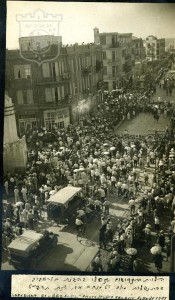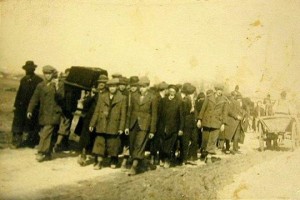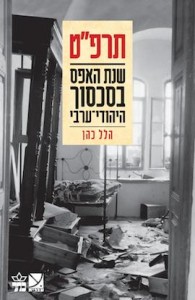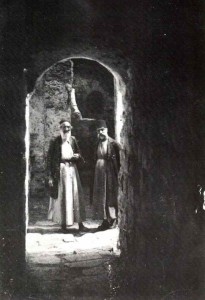The Year Palestine Became a Zero-Sum Game – 1929
REVIEWS, 20 Jan 2014
Ran Greenstein - +972 Magazine
After 1929, Arabic-speaking Jews who had lived in peace and cultural affinity with fellow residents, and orthodox Jews who had shunned Zionism, could no longer feel safe among their erstwhile neighbors and friends. They had to rely on the new Yishuv to protect them from then on, and they never looked back. Introducing new information and highlighting forgotten facts, a new book by Hillel Cohen brings fresh context to the 1929 massacres in Mandate Palestine.
It is not easy to write history in a popular and accessible manner, all while retaining academic precision and professional credibility. Prominent historians of the Israeli-Palestinian conflict, such as Benny Morris and Ilan Pappe, tried to do that in recent books and have been subject to criticism for sloppiness and overtly political bias that detract from the scholarly value of their earlier work. Hillel Cohen’s new book, 1929: Year Zero of the Jewish-Arab Conflict (Keter, 2013), however, proves it can be done.
This is a remarkable book not only for its content but its structure as well. It is written in a non-linear fashion, using a question-and-answer format that breaks the story into small easily digestible chunks, and uses plain prose avoiding academic jargon and fancy theory. All this aims to remove the usual entry barriers that generally make academic work less accessible. And yet, its simple style does not make for simplistic analysis, nor does the easily flowing narrative come at the expense of the need to remain grounded in written documents and oral evidence, and use the standard tools essential to serious historical writing.
What is special about 1929? It was the year in which serious country-wide ‘disturbances’ (to use the official term) took place for the first time during the British Mandate period, including mass attacks on Jewish settlements and neighborhoods. Above all, it became notorious for the massacres carried out in Hebron and Safed, homes to well-established Jewish communities that preceded the new Zionist settlement project by centuries. In the Israeli-Jewish collective memory, 1929 provides the ultimate proof that there is ‘no partner’ for a political agreement with Palestinians, who would stab any Jew – regardless of his/her personal history or political affiliation – in the back, if given half a chance. The notion that all Arabs wish to throw Jews into the proverbial sea has its origins in that year. But, as Cohen demonstrates in the book, this is the impact not so much of the real, historical, events of 1929, but the way in which they have been reconstructed and represented in subsequent political and cultural discourses.
In a sense, all historical events are mediated through politics and culture. They never reach us in a pure form. This is true, of course, for 1929 as well, though its crucial role in shaping the course of the Israeli-Palestinian conflict means that the degree of political manipulation, use and abuse, has been larger than usual. Cohen does not wish to debunk the main story line from a Zionist perspective – the attack on and massacre of innocent civilians – but rather to contextualize it, sort out narrative discrepancies and queries, and provide an explanation, where possible, for its specific course and effects.
In the process he presents information not known before or not sufficiently highlighted. That the Arab attackers felt provoked by Jewish moves to change the prevailing arrangements in the Western Wall prayer space, that rumors of atrocities committed by Jews against Arabs fueled the wrath of Arab rioters, that Jewish attacks on Arab pedestrians in Jerusalem and Tel Aviv preceded or coincided with the Arab attacks, that Jews also murdered Palestinians in the course of the events, though not on a large scale, that many Palestinian residents helped their Jewish neighbors by standing up to the attackers and preventing them from harming Jews, that no solid evidence exists that the Palestinian leadership – especially Hajj Amin al-Husseini, the grand villain of Zionist historiography – incited the rioters, let alone that they operated on its instructions, that the British forces did not facilitate the attacks and usually tried to stop them but were not always quick enough, and so on. Most of the evidence Cohen presents is not new but he digs up evidence that remained obscured and organizes it into a coherent narrative that gives an overview of developments in different parts of the country, and makes sense of the story.

A funeral for Jewish casualties in the 1929 ‘disturbances’ in Tel Aviv.
(Photo: Shoshana Ulstein/Bezalel Studio)
Beyond the general picture he tries to understand the specific features of each case, particularly that of Hebron. The tendency of younger Jews in that community to identify with the Zionist movement was a factor that contributed to it being targeted. Evidence about clashes between Jewish newcomers – American religious students – and local residents, and tensions related to the role of a Jewish-owned bank in the lives of indebted peasants in the region, provides a context for the particularly vicious nature of the violence in that town, though of course it cannot possibly justify any of it.
All these useful and interesting details cannot disguise the central question: why were the attacks focused on the one section of the Jewish population that had the least to do with the new Zionist-inspired and led settlement of the country? How can the Palestinian historical narrative, that presents the 1929 events as a popular insurrection against the growing impact of Zionist settlement, explain the specific concentration of attacks in places and on communities that had little to do with Zionism and apparently became victims only because of their shared Jewish identity?
Cohen does not provide a single answer, but there are various possible explanations. In part, this is because small and isolated communities were easier targets. In part, because Palestinians living in rural areas were more likely to be influenced by unsubstantiated rumors and act spontaneously with little regard for the consequences. The better organization of the new Jewish community (the Yishuv), including its access to arms, made the prospect of attacking it more risky and therefore less likely, and in cases where attacks did take place, armed Jewish fighters could repel them and thus prevent serious loss of life among the defenders.
Beyond all this, the context was crucial. In an environment inflamed by religious conflict over access to and ownership of the holy places, reason was replaced by emotion and the differences between Jews of different backgrounds and affiliations became blurred. This had been noted already in a previous round of ‘disturbances’ in 1921, when the Haycraft Commission of Inquiry concluded: “During the riots all discrimination on the part of the Arabs between different categories of Jews was obliterated. Old-established colonists and newly arrived immigrants, Chalukah [Halukka] Jews and Bolshevik Jews, Algerian Jews and Russian Jews, became merged in a single identity, and former friendships gave way before the enmity now felt towards all.”
Cohen rightly presents a similar explanation as central not only to our understanding of what happened in 1929, but also – more importantly – for what has happened since. Armed conflict always tends to strengthen the support of disparate members of the community for their nationalist leadership. In fact, conflict creates the national community by eliminating internal boundaries and enhancing solidarity against the external enemy. Both for practical and political reasons, 1929 eliminated the space that had existed for cross-cutting loyalties and affiliations. The Arabic-speaking Jews who had lived in peace and cultural affinity with fellow residents, the orthodox Jews who had shunned Zionism, could no longer feel safe among their erstwhile neighbors and friends. They had to rely on the new Yishuv to protect them from then on, and never looked back.
The consolidation of Jewish unity was mirrored by the growing recognition among Palestinians that the fate of the entire country was at stake, and that only resolute struggle would allow them to save their homeland. It opened the way to the national strike in 1936 and the Arab Revolt of 1936-39. and, in turn, it led to the growing militarization of the Jewish community. The result was increasing conceptualization of the conflict in mutually exclusive terms, eventually leading to the climax of 1948, the creation of Israel and the Palestinian Nakba. In an evocative side-story, Cohen links the early childhood experiences of future military leaders – whose families were attacked in 1929 – to their attitudes in 1948. People like Mordechai Maklef and Israel Tal, who played a role in driving Palestinians from their homes in 1948, had been shaped by the formative violence of the 1929 events, as were an entire generation of young Jews in Palestine.
Cohen recognizes that there were forces opposing these trends but does not pay much attention to them, for understandable reasons: they were weak to start with and were further marginalized by the events. Nevertheless, their story is important and deserves a more thorough exposure. The bi-nationalist association Brit Shalom was shaken by the events in a way that became typical to Jewish liberals in the history of the conflict: some of them moved to the mainstream while others became radicalised. Among the members of the association, its prominent founder Arthur Ruppin became disillusioned regarding the prospects of Jewish-Arab agreement and effectively abandoned the quest for bi-nationalism, coining the famous phrase: “What we can get (from the Arabs) – we do not need, and what we need – we cannot get.” His colleague, Hans Kohn, moved in an opposite direction, leaving the association because of its inability to offer radical criticism of political Zionism, eventually departing both from the Zionist movement and from Palestine itself. Bi-nationalism, whose advocates were rooted in one national group only, without a clear partner on the other side, faced a serious problem during the entire period in question.
The Palestinian Communist Party – the only Jewish-Arab political force in the country, then and since (albeit at that period still with majority Jewish membership), experienced a similar process. When its central committee members found themselves caught between potential Arab rioters and armed Jewish militants, they allowed themselves to be evacuated from their secret headquarters in Beit-Safafa near Jerusalem. Years later, its only surviving leading member Joseph Berger-Barzilai, wrote up the story in an article titled “Jerusalem, August 1929” (in Keshet Magazine in 1965). His party initially referred to the events as a pogrom, only to be severely reprimanded by the Communist International as suffering from Jewish tribalism and Zionist sympathies, for which the only solution was a thorough process of Arabization. The outcome was the promotion of an Arab leadership at the expense of Jewish cadres, the departure of many disillusioned Jews, and the beginning of a period of ripping the movement apart between competing nationalist agendas.
How can we learn from these developments and create new bi-nationalist and Jewish-Arab political forces that will overcome the limitations, and correct the mistakes, of their predecessors? The answer cannot be found, of course, in Cohen’s book, but he raises crucial questions that provide us with a necessary background for subsequent discussion and analysis. The book is essential reading in order to gain a better understanding of the past, and is useful for drawing lessons for the present.
__________________________
Ran Greenstein is an Israeli-born associate professor in the sociology department at the University of the Witwatersrand, in Johannesburg, South Africa.
Related:
How the 1929 Hebron massacre invigorated the Zionist movement
DISCLAIMER: The statements, views and opinions expressed in pieces republished here are solely those of the authors and do not necessarily represent those of TMS. In accordance with title 17 U.S.C. section 107, this material is distributed without profit to those who have expressed a prior interest in receiving the included information for research and educational purposes. TMS has no affiliation whatsoever with the originator of this article nor is TMS endorsed or sponsored by the originator. “GO TO ORIGINAL” links are provided as a convenience to our readers and allow for verification of authenticity. However, as originating pages are often updated by their originating host sites, the versions posted may not match the versions our readers view when clicking the “GO TO ORIGINAL” links. This site contains copyrighted material the use of which has not always been specifically authorized by the copyright owner. We are making such material available in our efforts to advance understanding of environmental, political, human rights, economic, democracy, scientific, and social justice issues, etc. We believe this constitutes a ‘fair use’ of any such copyrighted material as provided for in section 107 of the US Copyright Law. In accordance with Title 17 U.S.C. Section 107, the material on this site is distributed without profit to those who have expressed a prior interest in receiving the included information for research and educational purposes. For more information go to: http://www.law.cornell.edu/uscode/17/107.shtml. If you wish to use copyrighted material from this site for purposes of your own that go beyond ‘fair use’, you must obtain permission from the copyright owner.


